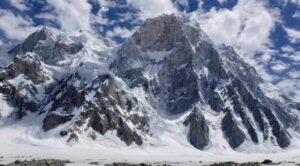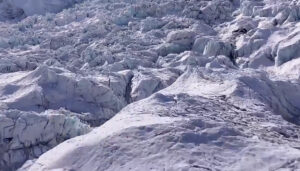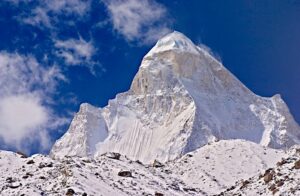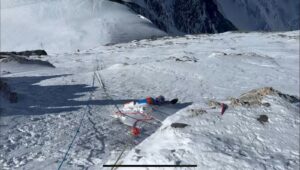Editor’s Note: This story has been corrected to reflect new information from several sources that Elisabeth Revol used supplementary oxygen on her climbs of both Everest and Lhotse. Reference to her no-O2 climbs has been cut pending further clarification.
On May 23, Nirmal Purja summited Everest and Lhotse within eight hours. He then flew to Makalu and summited that as well. Back in Base Camp, he posted the feat on social media. But for this ex-Gurka soldier, his triumph was not celebrated as expected.

Nirmal Purja on Everest.
Some devoted fans did praise Purja, but one of the pictures he shared, in which he didn’t even appear, dwarfed all other aspects of his post. In it, a long line of human figures wrapped in colourful down suits pressed against each other along a sharp ridge toward a summit. The summit of Everest.
The image went viral within minutes. In hours, it had triggered millions of negative comments in hundreds of languages. Later, general media stories analyzed the possible motivations and vanity which led nearly 300 people to endure that dangerous mess in order to set a foot on a piece of rock and ice.
News of deaths in the following hours, and some highly dramatic testimony from those present, added gasoline to the fire. Jagged Globe’s manager David Hamilton, back from his 10th Everest summit, told the BBC that the reality was even worse that the pictures. Filmmaker Elia Saikaly topped for the third time and described an insane scene of “Carnage, chaos… people dying… walking over dead bodies.” Then he added that he had filmed it all and that the images will make “a heck of a ride of a documentary.”
Expert comments gave critics moral support for trashing the “tourists” who crowded a place they shouldn’t have reached, thanks only to money, loads of O2, massive Sherpa support and kilometres of rope. “We should elevate ourselves to the mountain’s difficulties and not downgrade the mountain to our capacities,” endurance athlete Kilian Jornet posted on Twitter.
Fair means seemed to be the key factor separating praise from disdain. It’s style versus trophies, ambition versus purity, money versus experience and skill. All that backlashed on Purja, who inadvertently found himself in the crossfire. Both the general public and some very seasoned climbers disdained Purja’s “whatever it costs” approach: limitless oxygen, fresh Sherpas on each ascent, far-from-green helicopter flights everywhere, runs up mountains with all the infrastructure of camps, ropes, etc. The mountaineering website RussianClimb compared his “Guinness record” claims to setting an “Olympic record using doping.”
Even the charitable aspect of Purja’s challenge, while popular in the UK, was not seen so charitably elsewhere. If someone wants to help children, the argument went, he should donate the huge sum of money that these expeditions cost directly to needy kids.

Nirmal Purja’s infamous and already oft-published May 23 photo.
Meanwhile, Juan Pablo Mohr of Chile successfully summited Everest without oxygen. David Göttler, also climbing sans O2, turned back a mere 200 vertical metres from the summit when he ran into the traffic snarl. He figured that he would be too dependent on how the crowds moved (or didn’t move).
“My decision to leave late and have the warmth of the sun worked really well until just below the South Summit,” he said later. “There, the weather started closing in and I ran into all those people coming down. I made the decision to turn around at 8,650m — waiting and wasting energy is not an option up there without supplemental oxygen.”
He took pains to point out that he wasn’t complaining. “I don’t feel like a victim of the masses here, ” he said. “I knew what to expect. Why do people here get upset? They should have known what they were getting into.”
Göttler concluded that he probably should have set off from Camp 4 earlier. Mohr did just that and managed to summit ahead of the worst crowds.

David Göttler wearing not O2 but a protective mask. Photo: David Göttler
So a handful of “prestigious” no-O2 climbs prove that Everest can be summited that way, against nearly a thousand clients going for it while sipping oxygen. Of these, 850 summited and 10 died. The public verdict is clear: Hail to the no-O2 climbers, a pox on the rest.
Is this totally fair, however? Is it despicable to try to reach the top of the world with all the advantages that money and technology can buy? Can anyone summit Everest if they have enough support? The answer to the two first questions depends on one’s personal view. As for the third, definitely not. Climbing Everest, even with supplementary oxygen, ropes, camps and all the best gear remains a serious challenge which demands training and exceptional mental strength.
The backlash centres around the motivation behind climbing Everest. All explorers, mountaineers, polar travelers, long-distance hikers have reasons for doing their adventures. Some of these reasons are admirable: curiosity, courage, raising awareness for some virtuous objective, etc. Others are more personal, and sometimes dark. Often, the inner motivation to carry out something remarkable has to do with ego and the need for recognition.
In the adventure domain, nothing represents ego and self-recognition like reaching the highest point on earth. These people literally stand above of all other human beings. No wonder Everest is a magnet to human ambition. No wonder some men and women hope to enlarge their success in business and in life by reaching the real top of the planet. No wonder some of them include the title “Everest summiter” on their business cards for the rest of their lives. And no wonder that there’s a backlash against this.

“And you thought we would be impressed?” One of the countless memes currently on social media. This one, from Spain, depicts Madrid’s subway reaching new heights.
As humans, we’re more than ready to disparage those driven by their own vanity. This year, the backlash has been particularly resounding, thanks in no small part to Purja’s worth-a-thousand-words photo. Those nurturing a triumphant image of themselves, fist in the air, the mountains at their feet, have been criticized and even laughed at as part of the pathetic traffic jam on the Hillary Step.
Saddest of all, some of those who happily shared their selfies on the way to Base Camp, smiling in the sun with a background of mountains, died on some stupid, jammed push to the summit of vain ambitions.
But behind each of those masked figures on the Hillary step is a story. A story of inexperience and recklessness, in some cases; a story of long years of preparation and alpine experience in others; or a story of a simple, honest way to make a living.
The inner motivations which pushed each of those reaching 8,848 metres above sea level compose the inner truth that will either gratify them when they return or echo in their heads on the last moments of their lives.






